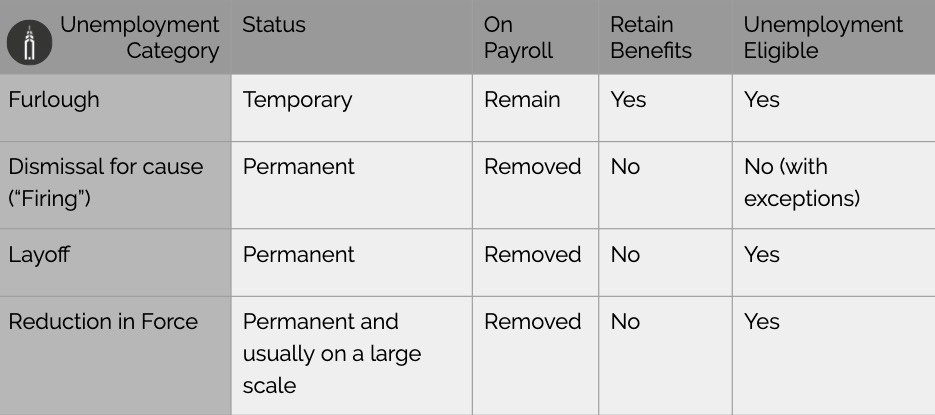Unusual times may be cause for a temporary changes for your workforce.
One of those unusual circumstances might be an economic shock. And one of those tools is furloughing employees.
Put simply, where dismissals and layoffs are permanent, a furlough is, by definition, temporary. Perhaps best known to be used by governments during budget impasses, the tool came to widespread private sector use during this pandemic-driven recession exactly because this economic shock was perceived to be temporary. Many governments stepped in — fully half of British private companies were expected to furlough employees.
Despite recent gains, unemployment will likely sustain at levels not seen since The Great Depression. It could take a decade to undo the destruction of just a few months. That threat is worse for Black Americans than white.
With future waves of COVID-19 still possible, the American economy does appear to be growing again. Many companies, especially ones that rely heavily on employees who can easily work from home (like technology), are back to growth. That means those companies that did furlough employees are now bringing them back.
To better understand the process, Technical.ly recorded this episode of The TWIJ Show, a weekly interview series focused on building better companies, on how to furlough employees — and support them when they return.
Note that this episode was recorded at the end of May, before a crucial national conversation on racial equity took hold. So though equity is embedded in elements of all employment practices, the last month of powerful protests will not be directly referenced.
To talk furloughing, I interviewed Talia Edmundson, principal and founder of HRnB Consulting, who was previously the longtime director of human resources for RevZilla, the motorcycle culture online retailer. I also spoke with Tamara Rasberry, a D.C.-based HR consultant with a focus on mental health, inclusion, diversity and equity. She’s the founder of Rasberry Consulting.
Determine if furloughing is the right step.
When business leaders look at an underperforming team or mismatched revenue and expenses, there are several different approaches to address the size of their workforce.
For disciplinary action, there are dismissals for cause — the “firing” of an employee that is an entirely different category. There are reductions in force and layoffs, two terms that are sometimes used interchangeably but do have a nuance in labor law. On the whole though, these are done when there is the expectation that those roles will not be replaced.
Recessions are always a function to make an economy more efficient by eliminating roles and firms that are understood to be less efficient or productive. Though it’s been estimated that as many as two of every five jobs lost in this economic shock may never return, the rest will.
Furloughs are best when you expect you are confronting a short-term budget shortfall. As economists sometimes put it: This is the difference between a firm with a liquidity problem, not a solvency problem.
Putting employees on furlough is typically seen as more efficient than a permanent job loss, since it allows for a quicker economic return once that business picks back up — as presently seen in Denmark.

Plan thoroughly for the act of furloughing.
Once you know you’re moving forward with furloughing one or many employees, this is an act of planning. Just like a more permanent layoff, you need to plan for the stress it will cause both the employee and the staff who will remain.
If employer branding suggests you should care very much how you treat any former employee, if you logically intend to bring this employee back, it is even more important they have as positive an experience as possible.
“People take notes,” said Edmundson. It’s during moment of stress that we most learn about our companies, she added.
Things to keep in mind: when, where and how are you updating someone; how much information do you have about how long the furlough will be; why this person or this team. Typically a furloughed employees retains their benefits (like health insurance). Make that clear upfront.
During a layoff or dismissal, it’s typically advised to keep things short and direct. A furlough is somewhat different, in that this may be entirely beyond this person’s control and they are still an employee of your company. Put considerable care into your plan.
“Don’t fake it,” said Edmundson. Read Edmundson’s guest post on just this topic here.
Maintain communication during the furlough.
You need to keep in touch with employees during their furlough — but don’t overdo it, says Rasberry.
If you aren’t paying an employee, do not ask them to do any work. Stay consistent. If you are a manager with a good rapport with that teammate, you may do an occasional text check in, perhaps once a week. If your workplace is more formal, you might email them personally or call them directly once or twice a week. This level of communication is something worth determining before, and updating that teammate from the start.
“If you never were a company that did surveys, don’t suddenly put out a pulse survey to see how your furloughed employees are feeling,” said Edmundson. It will feel disingenuous.
Think about the reboarding.
The moment you plan to furlough someone, you are also planning to reboard this person. Have a plan from the start — even if that plan might shift due to economic changes. These employees were told they were nonessential. How might that make you feel?
Will their work email password be changed? What other access will have been removed? How will those be turned on? Start with your existing onboarding process and refine it for someone who was already part of your team. There can be a level of embarrassment or frustration.
“Do it in the most humane way you can think,” said Rasberry.
All around, remain consistent.
This is yet another reason why in good times, you want to invest in good communication.
If as a manager or a CEO or an HR professional, you were seen as stiff and distant, it will seem hollow for you to appear to seem compassionate now. If you didn’t get regular staff feedback, that can’t change now.
As always, internalize empathy. As Rasberry put it: “How would you want your mom to be treated?”







